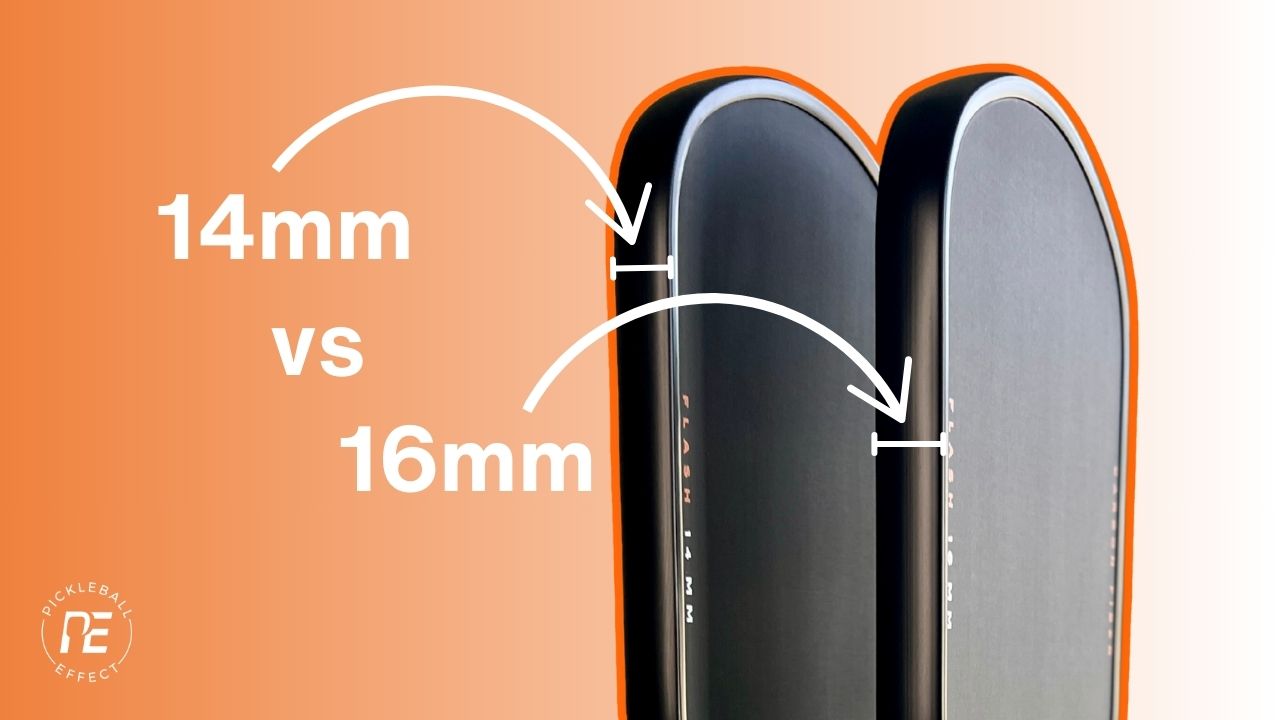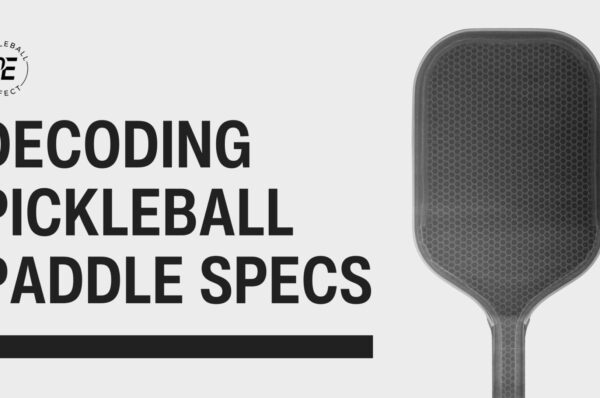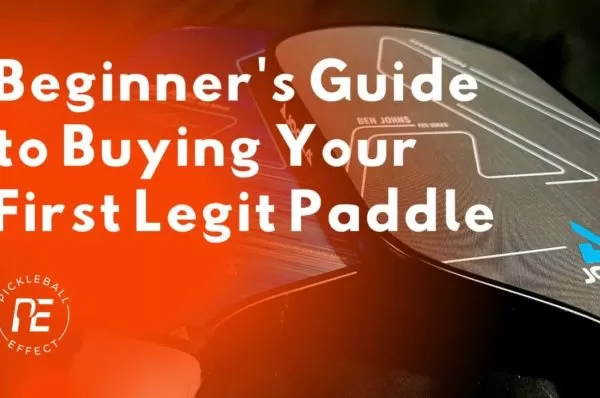Before you point out that the difference between 14mm and 16mm is just 2mm, let me get ahead of you! This is a long-standing joke I often hear on the subject, but it’s an interesting topic that not everyone fully understands. It’s common for brands to offer their paddles in these two thickness options, but what exactly is the difference? I’m going to lay out six key distinctions between these thickness options to help you choose the right one for you.
Before diving into the details, it’s important to note that the principles I’ll discuss are generalized and not always applicable. There are unique cases where these principles may not hold true, but they are generally accurate, especially when comparing a 14mm and 16mm version of the exact same paddle.
Table of Contents
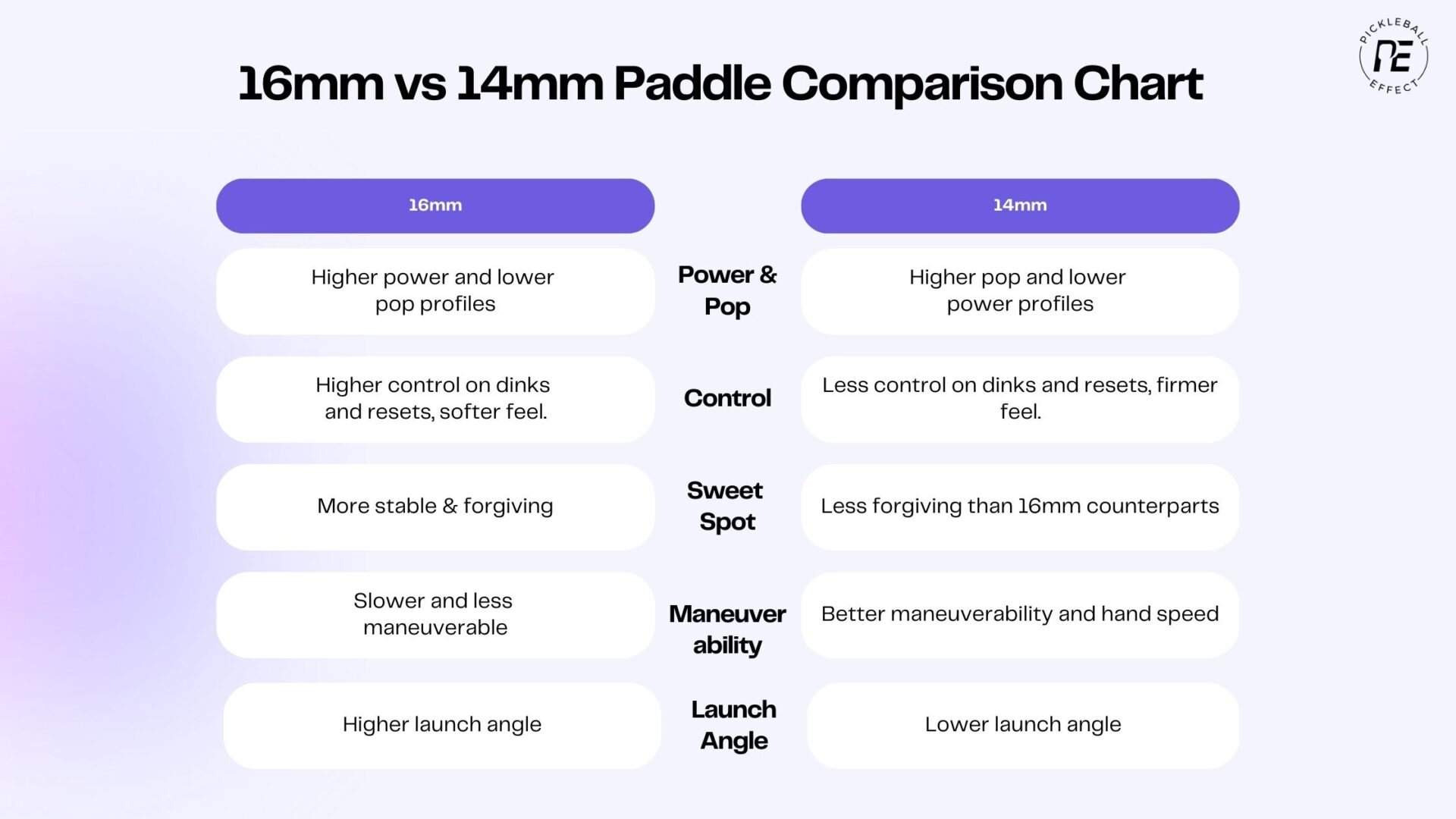
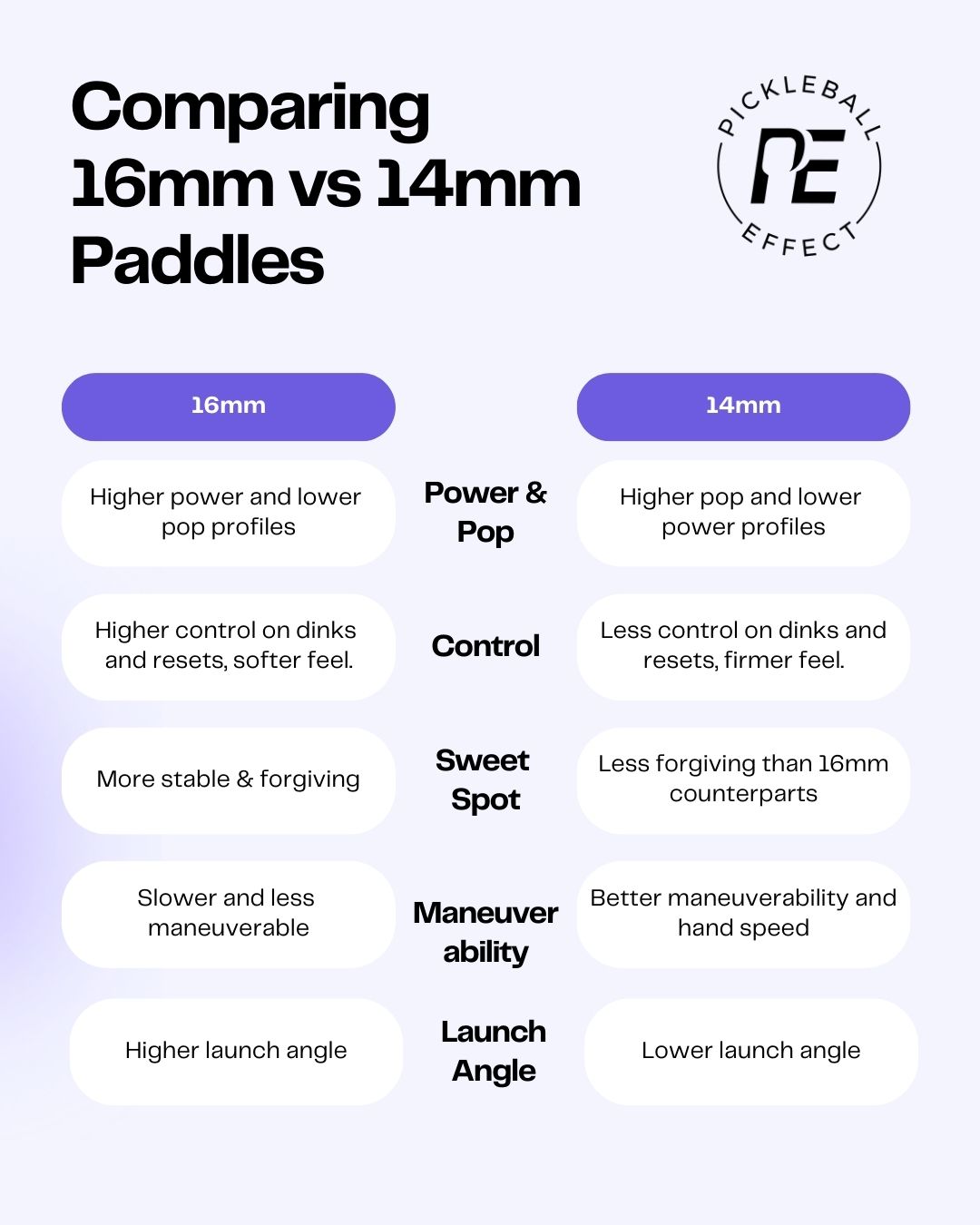
Power and Pop
Power is how much ball speed you can generate when doing a full swing like when hitting drives, serves, or overheads. Pop is how much ball speed you can generate with short swings like a dink or a punch volley.
16mm: 16mm paddles typically have a higher power and lower pop profile compared to their 14mm counterparts. The increased mass of 16mm paddles gives them more power on big swings, however, this extra mass also absorbs more pace off the ball during resets and dinks when you’re not swinging as hard which gives them less pop.
14mm: Compared to their 16mm counterparts, 14mm paddles have lower power and higher pop profiles. Thinner paddles typically have lower swingweights and less plowthrough, making it challenging to generate the same level of power as the 16mm versions. However, because they are thinner, the ball rebounds off quicker, making it easier to generate more ball speed with shorter swings like counters, flicks, and speed-ups. While 14mm paddles don’t generate the same level of power as 16mm paddles, you can modify your 14mm paddle by adding some weighted tungsten tape to the sides. This modification will provide the extra plowthrough needed to generate comparable power to their 16mm versions while still retaining the extra pop.
Control
Control describes how easy or difficult it is to control the pace of play and placement of the ball.
16mm: The thicker the core, the better it can absorb the pace of the ball when you’re taking short strokes during dinking or holding the paddle mostly still for resets. Thicker-core paddles have more mass and material for the energy of the ball to be transferred to. Because the paddle does more of the work in absorbing the ball’s pace, it’s easier to place your shots and control the pace of play without popping up as many balls. Additionally, 16mm paddles have a softer, more pleasant feel at impact that most people connect with better vs the stiffer, less plush feel of their 14mm counterparts.
14mm: Thinner-core paddles don’t absorb as much of the ball’s energy as 16mm paddles do, resulting in a poppy sensation where the ball jumps off the face more quickly. This is advantageous when you need offense at the net but disadvantageous when you’re trying to slow the ball down and place it into the kitchen. With 14mm paddles, controlling the pace of play requires more effort and skill from the player compared to using 16mm paddles. Then feel wise, 14mm paddles have a stiffer impact feel which some players like because of the extra feedback though most prefer the softer, plusher feel of 16mm paddles and think that feel is more conducive to controlling the ball.
Save on Pickleball Gear at Pickleball Central
Shop all your pickleball gear from paddles, bags, shoes, clothes and more at the top online retailer and save! Discounts vary by product and brand.
*Some exclusions do apply.
Code: Click link below to apply discount
Forgiveness and Twistweight
Forgiveness of a paddle describes how much energy is returned on off center hits or more simply, the size of the sweet spot.
16mm: As paddles get thicker, they become more stable and forgiving. A helpful metric for describing a paddle’s stability or forgiveness is called “twistweight.” This measurement ranges from 5 to 8, with 6.4 being about the average. A twistweight above 6.4 indicates a stable paddle, while anything below suggests a smaller sweet spot. I have a paddle database of over 200 paddles, where I measure the twistweight for each one. The average twistweight for 16mm paddles is 6.5, while for 14mm paddles, it is 6.1. These numbers confirm the difference you feel on the court.
14mm: As paddles get thinner, they become less stable and less forgiving. While some forgiving 14mm paddles exist, when you compare a paddle that has both a 14mm and a 16mm version built the same way, the 14mm version will have a smaller sweet spot.
Maneuverability
Maneuverability describes how easy or difficult it is to swing and move the paddle. Paddles that have good maneuverability improve your hand speed in fast volley exchanges and make it easy to accelerate through shots like drives and serves.
16mm: The extra material in 16mm paddles slows them down compared to 14mm paddles. They do not feel as easy to swing and do not cut through the air as well as 14mm paddles. A metric that is strongly connected to maneuverability is swingweight. Swingweight measurements range from 100 to 130, with higher numbers indicating more difficulty in swinging. A swing weight of 115 is considered mid-weight. In my paddle database, the average swing weight for a 16mm paddle is 117, while the average for 14mm paddles is 113.
14mm: This is one of the advantages of 14mm paddles. Their lighter swing weight compared to 16mm paddles makes them easier to maneuver. When you combine this with the extra pop that 14mm paddles offer, they become more effective for offensive play at the net.
Spin
I run spin tests on paddles and publish the results in my paddle database. When I run the tests I hit 10 serves with as much top spin as possible and measure the RPMs with a speed gun called the Stalker Pro 3S. Doing this test for over a 100 paddles hasn’t shown that thicker or thinner paddles have an advantage spin wise in this scenario.
However, when you’re at the kitchen dinking or looking to attack low balls, I do think you can generate more spin with 16mm paddles over 14mm paddles. Although I don’t have data to support this, it’s the impression I get when play-testing paddles. I believe it’s because 14mm paddles are poppier, so the ball leaves the paddle quicker and doesn’t compress as much as it does with 16mm paddles. That’s just my theory, though.
Launch Angle
Launch angle is a topic that I think I’m the only reviewer that talks about it. I describe launch angle as the angle at which the ball leaves your paddle, and I believe that 16mm paddles have higher launch angles than 14mm paddles. This means that when you hit a drive, drop, or roll volley, with a 16mm paddle the ball takes off higher and follows a loopier trajectory compared to 14mm paddles. Conversely, 14mm paddles have a flatter launch angle, and you’ll notice the ball staying lower when hitting those same shots.
I did a test once with this where I took two paddles (Engage Pursuit EX and EX 6.0) where the only difference was the paddle thickness. The EX is 13mm thick while the EX 6.0 is 16mm thick. Using a high frame rate camera I tracked the ball flight of five shots using each paddle and charted it below.
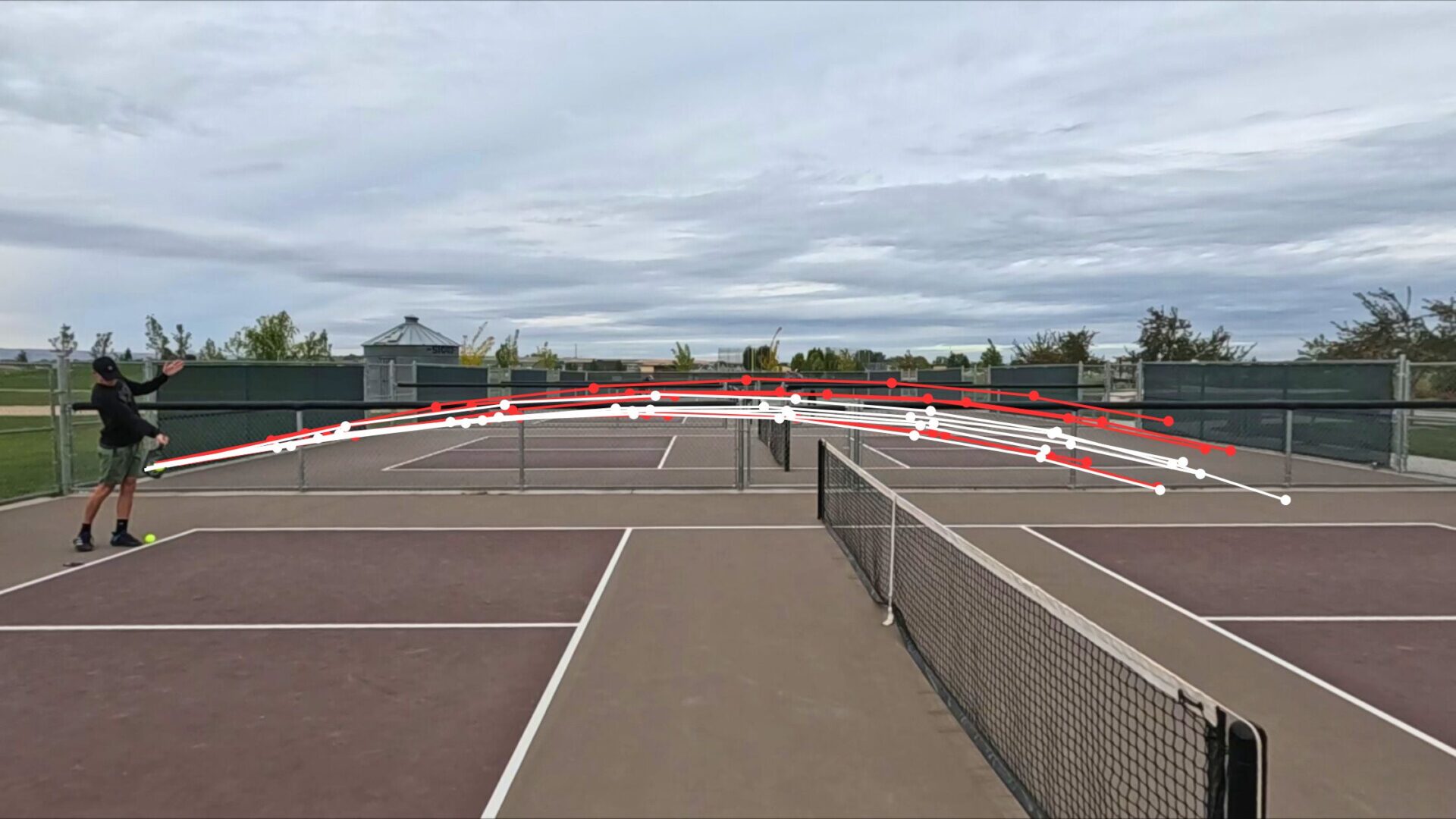
The red line shows the ball flight of the EX 6.0, while the white line shows the ball flight of the EX. The thinner paddle was pretty consistent with its flight and generally remained lower than the EX 6.0. I realize this test isn’t perfect, but it did align with my hunch that 16mm paddles have a higher ball flight.
Why does this matter? Personally, I am able to control and be more consistent with my drops using a paddle with a lower launch angle. Something about my swing works better with it, so I prefer thinner core paddles for that reason. I also believe that a flatter launch angle is an advantage when you’re attacking semi-high balls at the net and trying to target your opponents’ feet on the other side. The downside is that it’s more difficult to hit the ball deeper in the court on returns, and you may find the net more often. Paddles with higher ball flights are better suited for players who can generate a lot of spin and are more effective when attacking low balls because it helps them get the ball over the net more easily.
Again, this is empirical data and information, but it is something to consider when choosing the right paddle thickness for you.
What Thickness is Best for You?
The majority of players use 16mm paddles because they are more forgiving and have a softer feel, making them more player-friendly and easier to play with overall. This makes them ideal for newer players who need extra forgiveness and help with soft shots, as those are the hardest shots to learn. Many advanced players also choose 16mm paddles for the same reasons.
However, I don’t believe this means players should dismiss 14mm paddles altogether. The extra pop and maneuverability are really advantageous at the net when you’re trying to finish points, which becomes increasingly challenging as you level up. If you’re a higher-level player, say 4.25 or above, I think you should try out a 14mm paddle to see if the added benefits of extra offense outweigh the losses in forgiveness and potentially some control. Conversely, if you’re not a higher-level player, I think the benefits of 16mm paddles outweigh those of 14mm paddles.
Save on Pickleball Gear at Pickleball Central
Shop all your pickleball gear from paddles, bags, shoes, clothes and more at the top online retailer and save! Discounts vary by product and brand.
*Some exclusions do apply.
Code: Click link below to apply discount
Braydon competes at the 5.0 level and plays in 5-10 tournaments a year. He plays/drills 3 to 4 times a week and would play more if time allowed it.


